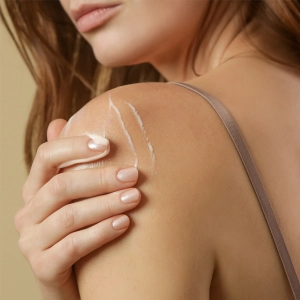Actinic keratosis
Pääsivu:Ihoaiheet
article.category:Skin Diseases
Actinic keratosis (Greek: aktis = [sun] ray, kera = horn) is a skin disease caused by UV light. It is widespread and is regarded as an early stage of a specific type of white skin cancer, squamous cell carcinoma. Actinic keratosis must always be treated as it can have life-threatening consequences.

Cause
UVA and UVB rays (sun, solarium) cause changes in the genetic material of the cells in the upper layers of the skin. As a consequence, the cells start to multiply in an uncontrolled manner. Actinic keratosis develops.
Actinic keratosis usually manifests as scaly, reddish or yellow-brown skin changes of between one millimetre and up to two centimetres in diameter. A further typical characteristic is that the affected areas of the skin feel like sandpaper. Actinic keratoses mainly develop where the skin is exposed to a lot of sun. These areas include the face and the scalp (especially bald patches in men), but also the ears, the cleavage and the backs of the hands.
Men are more commonly affected by actinic keratosis than women, as they work outdoors more often (e.g. construction industry, road construction and landscape gardening, agricultural sector) and are thus more exposed to the sun. However, people with light skin are also among those at risk as they have less natural protection from the sun. People whose immune system is permanently impaired (e.g. due to medication after an organ transplant) are also at particular risk. Finally, viruses belonging to the group of human papillomaviruses (HPV) can also favour the development of actinic keratosis.
While actinic keratosis mainly occurred above the age of 50 in the past, younger people are also affected today as leisure activities have changed and solaria are visited more frequently.
Options for treatment
Actinic keratosis can usually be treated without producing any scarring and generally also as an outpatient procedure. The choice of treatment method depends on the size, depth and location of the affected area of skin, age and health status of the patient. Smaller, isolated areas of skin that are affected can, for example, be removed surgically or treated with liquid nitrogen (cryotherapy). Freezing kills the superficial skin cells in a targeted fashion, which are subsequently replaced by healthy skin cells. A caustic solution can also be applied to small changes, thereby removing them.
Therapy with specific creams or gels is possible in cases of actinic keratosis affecting large areas of skin. These must be used regularly and over several months. The affected area of skin is also first treated with cream in photodynamic therapy, making the cells that have changed particularly sensitive to light. Subsequent irradiation with a special light source (strong red light) kills the cells and these are replaced by healthy skin cells. The surrounding, healthy skin remains largely unaffected by this method.
Finally, lasers or chemical peeling, as well as devices that abrade the affected areas of skin, can also be used to treat actinic keratosis.